Creating your garden oasis that will survive and thrive
In an age when Climate Change is a growing concern
Every hummingbird who visits my desert garden signs a registration book. My favorite comments so far this Spring:
”Your cactus garden should be a UNESCO world site! Can you do something about the Harris Hawks?”
“Nested here last spring. Agree with the bees! Love your Eden!”
“(Hic) Lovelier than the over-rated Garden at Versailles and (hic) I liked the touch of Tequila (hic) in the feeder.”
In the warming years ahead they can tell their fellow hummingbirds and their great-great-grand-chicks my garden will still be here, surviving and thriving. If you want a water smart desert garden that will survive the carnage of climate change all you have to do is:
Plant sun-loving drought resistant native plants.
Harvest and channel your rainwater.
Love digging, chopping, trimming, raking, weeding, pruning, planting, potting, potting up, brushing up against cholla, plucking thorns out of your thumbs and recovering from sunstroke.
I live in my desert garden because I can’t afford the therapy I need.
So I kvetch at my cacti, mumble at my mesquites and yuck it up with my yuccas. The world sucks less when I’m among my succulents.
When I preach that “All the problems of the world melt away when I garden” I’m spreading manure.
Ask me if all the problems of the world have melted away when my garden hose kinks and I’m in the the throes of crack-the-whip hose rage. Or when I’m cursing an elusive invisible thorn with a magnifying lens and tweezer, gritting my teeth like Rambo carving a bullet out of my arm. Ask me if all the problems of the world have melted away when I’m in the ER because while pruning a euphorbia I got the blinding toxic white juice in my eye and, like Magoo, I stepped on a bow rake.
Life Lesson Number One: There’s always an admission fee when you enter your desert garden.
My 5th grade teacher, Mr. Elder, who resembled a cross between Fred Rogers and Barney Rubble in a bowtie, taught us “The Garden” was all around us.
“What?” I thought he was nuts. In this lifeless, bleak and barren Sahara? Even out on our trampled patchy playground? “Why are we outside. Mr. Elder?”
“These little books are wildflower guidebooks. I want each of you to take one. Look around you on the ground. Match the plant with the picture and name as many as you can.”
What Mr. Elder called “beautiful wildflowers” I called weeds.
“Look closer, boy.”
I found one!
I identified one struggling Desert Purple Mat wildflower, plucked it and pressed it between the pages of the little booklet. I cannot explain why I remember that moment with such clarity but for a lifetime I’ve been looking closer ever since.
Life Lesson Number Two: Life is abundant here.
Look close at your desert garden and you’ll see the seasons, the agave blossoms that bring the bees and the desert honeysuckles that lure the hummingbirds, followed by the blizzard of Palo Verde petals drifting down like yellow ochre snow and the saguaro buds opening up as the season of relentless sun gives way to the season of cleansing fires in the distance and the rains that resurrect the abundance followed by the shorter days of autumn that bring the red cardinals and the winter rains that will germinate the wildflowers of Spring that will move our migratory snowbirds to say, ”Nice garden. Who knew a desert could be so beautiful?”
My parents worked tirelessly at turning their bladed desert moonscape into a lush Truman Show yard. They did it with the help of ridiculously cheap water and nurseries peddling their doomed water guzzling greenery. Miserable invasive losers better suited to Oshkosh than Tucson. Where there had once been jackrabbits and cactus wrens there were now only pigeons and concrete and my parent’s eternally struggling out-of-place garden and lawn.
Mr.Elder had planted a seed in my tiny head. “Mom! I want my own garden.” “Fine. Take the side of our house.”
I planted three tiny cacti I had bought for a dollar apiece off a rack at S.S. Kresge’s. Under my mismanagement and neglect my miniature desert garden flourished. And within a season my hedgehog, pincushion and beavertail flowered, offering up spectacular vermillion, scarlet and magenta blooms that no pathetic African Daisy or Petunia could match.
When I got my own house and yard I spent a fortune learning what survives in a xeriscape and what does not. At the end of one brutal summer my exasperated wife said, “Go out there and recite the Gettysburg Address over your garden, Mr. Green Jeans.”
What did she expect me to say?
“We have come to dedicate a portion of that garden, as a final resting-place for those plants here that gave their lives, that that garden might live…The desert wildflowers, succulents and cacti who struggled here have consecrated it far above our poor power to add or detract. We here highly resolve that this garden of the drought-resistant and native plants shall not perish from the earth.”
I was so desperate I was ready to try a Zen rock garden. I gave that up when my wife suggested it wouldn’t survive because it was likely I’d kill the gravel.
With persistence, tweezers, Bandaids and Bactine I learned which desert plants would thrive with just the right amounts of shade, sunlight and water. After my first season of stunning blossoms I became an evangelist for desert Edens. “Gather round my garden bench, O ye sinners! Renounce your dead daisies and your pathetic patches of Bermuda and your water wasting ways. Trust the Xeriscape. Invite the desert into your garden and you will be rewarded with incomparable beauty.”
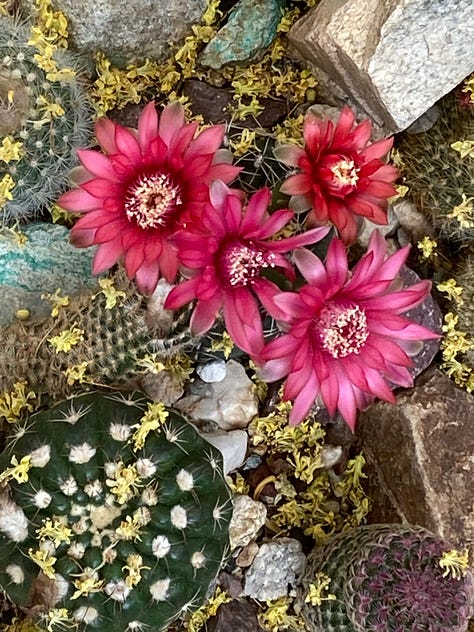


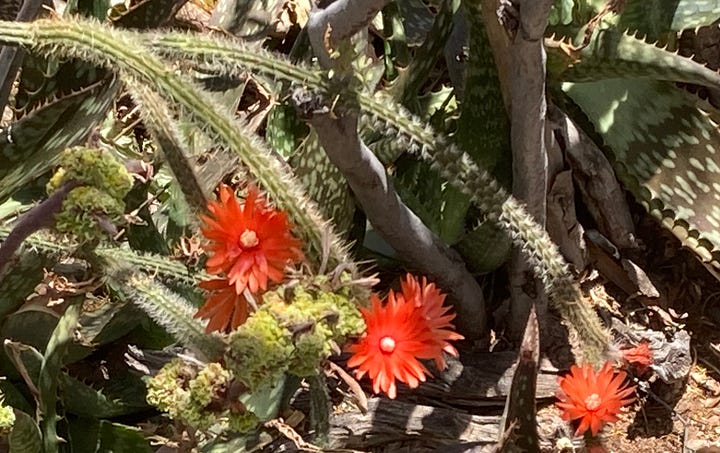
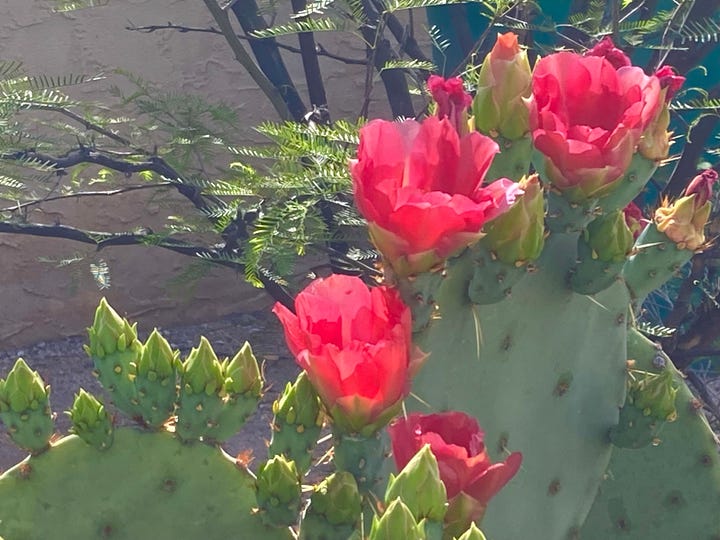
Here are some of my favorite desert plants that require a thimble of water to get launched and occasional verbal abuse to thrive. “Don’t be such a baby. It’s only 112 in the shade.”
Brittlebush. Grand for lining walkways or infill. Gray indestructible shrubs that produce an abundance of daisy-like blossoms.
Catclaw vine. Tenacious natives that claw their way up and over canyon walls offering up golden yellow flowers. Their grasping tendrils resemble tiny cat’s claws.
Desert Honeysuckle. A hardy shrub that produces hundreds of red trumpet-shaped flowers that will attract hummingbirds and butterflies to your garden.
Mexican sunflower. Beauties that can grow to rival a small tree in size. Producing giant flowers as big as saucers they’re good in soil or in pots.
Palo Verde. Worth it for the lacy shade and the seed pods which are sweet and delicious.
Mormon Tea. A good caffeine-like chew.
Hackberry. Thorny green leafy surefire shrubs that can be tamed and shaped into dense green bushes.
Creosote. Revere these ancient plants. They can live for hundreds of years, providing shade and shelter for every species of plant you might imagine. Every creosote in my garden is the guardian mother of numerous saguaros, hedgehogs, pincushions, agaves and organ pipes. Rub the leaves in your hand and you’ll smell rain.
Tall Boys. That’s what I call my Saguaros, Mexican Fence Posts, Totem Poles and Organ Pipe cacti. With just the right amount of water you’ll be surprised how fast they can grow.
Prickly Pear. Years ago we tore most the prickly pear out of our yard because packrats love nesting like packrats at the base of prickly pear. I haven’t had that much fun with a machete and a pitchfork since the last zombie apocalypse. We kept the one that produces blooms that rival any rose I’ve seen.
Ocotillo. Pluck the flowers and taste the nectar. You’re welcome.
You may have seen small white fluffy spots freckling a prickly pear. Smudge them and they’ll produce a red ooze. That scarlet ooze was cultivated as a dye at British plantations in the 17th century and used to color the colonial uniforms worn by the British redcoats so they’d be easier to target by we Yankees. Thanks, Prickly Pear.
Elephant Ears. My favorite prickly pear are not native prickly pear. Know as Elephant Ears or India Fig they have modest inoffensive spines and grow to an impressive height.
Jojoba. Ho-ho-ba. Lovely green shrubs. Rip out your lame privet hedges and grow these instead.
Agaves. There’s a huge variety, each with distinctive markings, colors and flowering stalks.
Please tell us your favorite cacti and desert dwellers in the comments below:
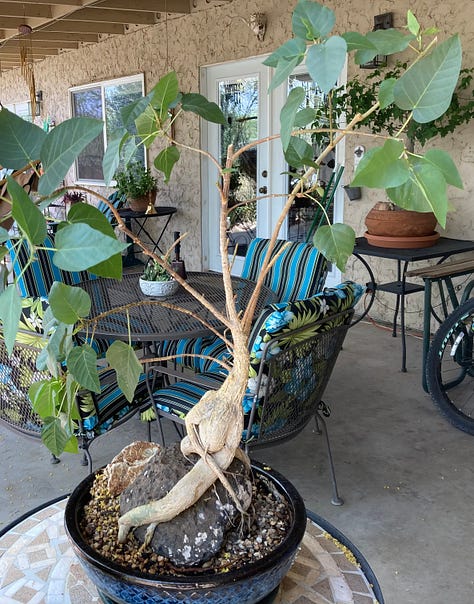
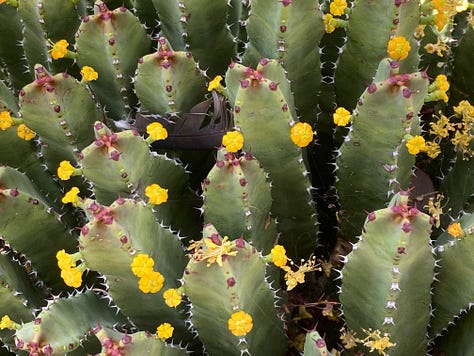
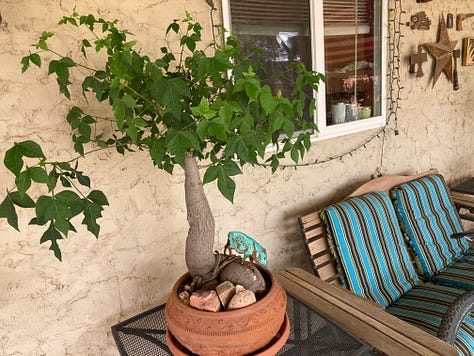
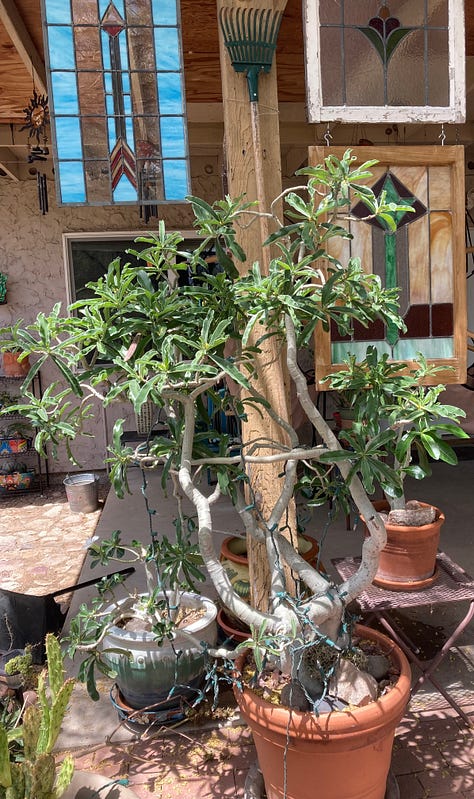
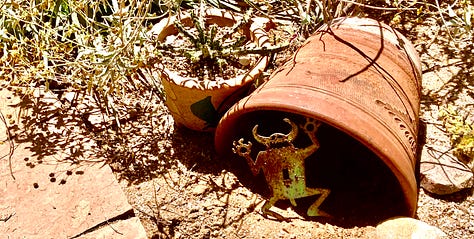
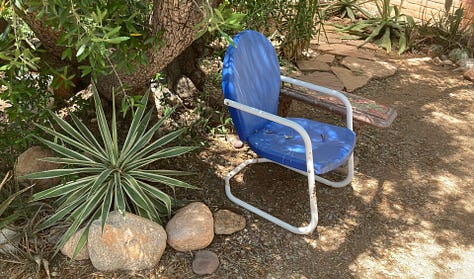
I’ve had success with a number of non-native plants from similarly arid corners of our planet I encourage you to try as well.
Adeniums. Adeniums are exotic beauties that love Tucson porches. Native to Africa and the Arabian Peninsula they look like small trees drawn into existence by Dr. Seuss. Possessing fat bases, long grey limbs, and thick green leaves like oleanders, Adeniums produce large vibrant pink, coral, or red flowers that are stunning.
Moroccan mounds. Moroccan mounds are perfect dome-like design elements, native to Morocco, that grow quickly.
Rock Figs. Native to the Sonoran desert in Mexico, they have bulbous bases and huge fig-like leaves. With their roots strangling the volcanic rocks in which they anchor themselves they are uncommonly beautiful porch plants.
Tucson is home to many fine nurseries and sources that sell drought-resistant plants. Here are my favorites. Please tell us your favorite sources in the comments below.
I was scrolling Amazon when I saw a T-shirt with the words, “I wet my plants” emblazoned across the front. Funny, but no sale. I rarely wet my plants. I’ll leave that to the channels I’ve dug for the rains and the occasional garden hosing which makes one feel like a benevolent God. I rarely wet my plants but oh how I love every resilient one. I urge you. Become a happy sunburned, thorn-scarred oxymoron in a straw hat with a spade. Become a desert gardener. Look close. You won’t believe the beauty you’ll find. At least that’s what Mr. Elder and the hummingbirds tell me.




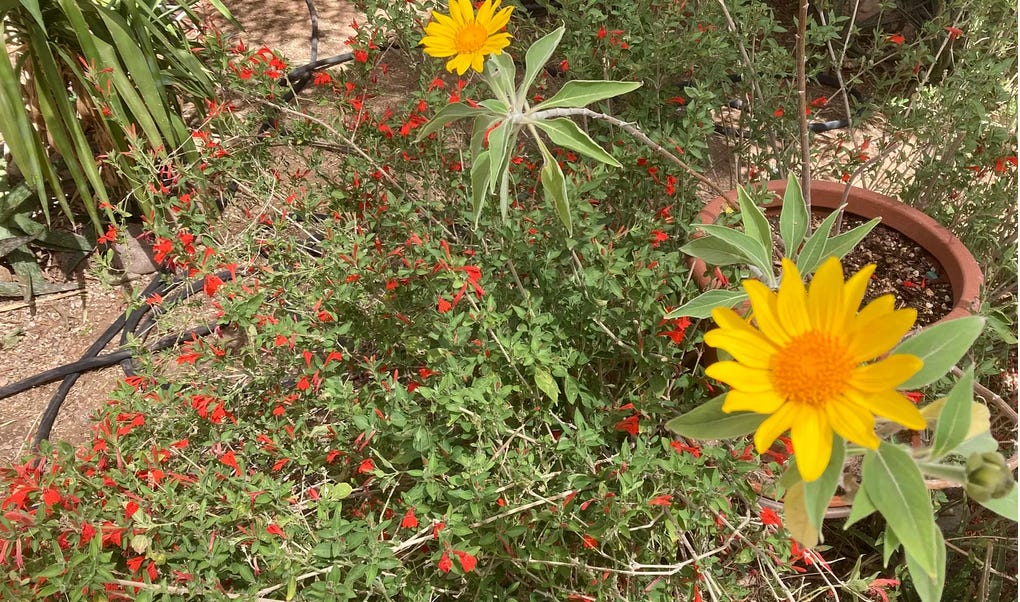
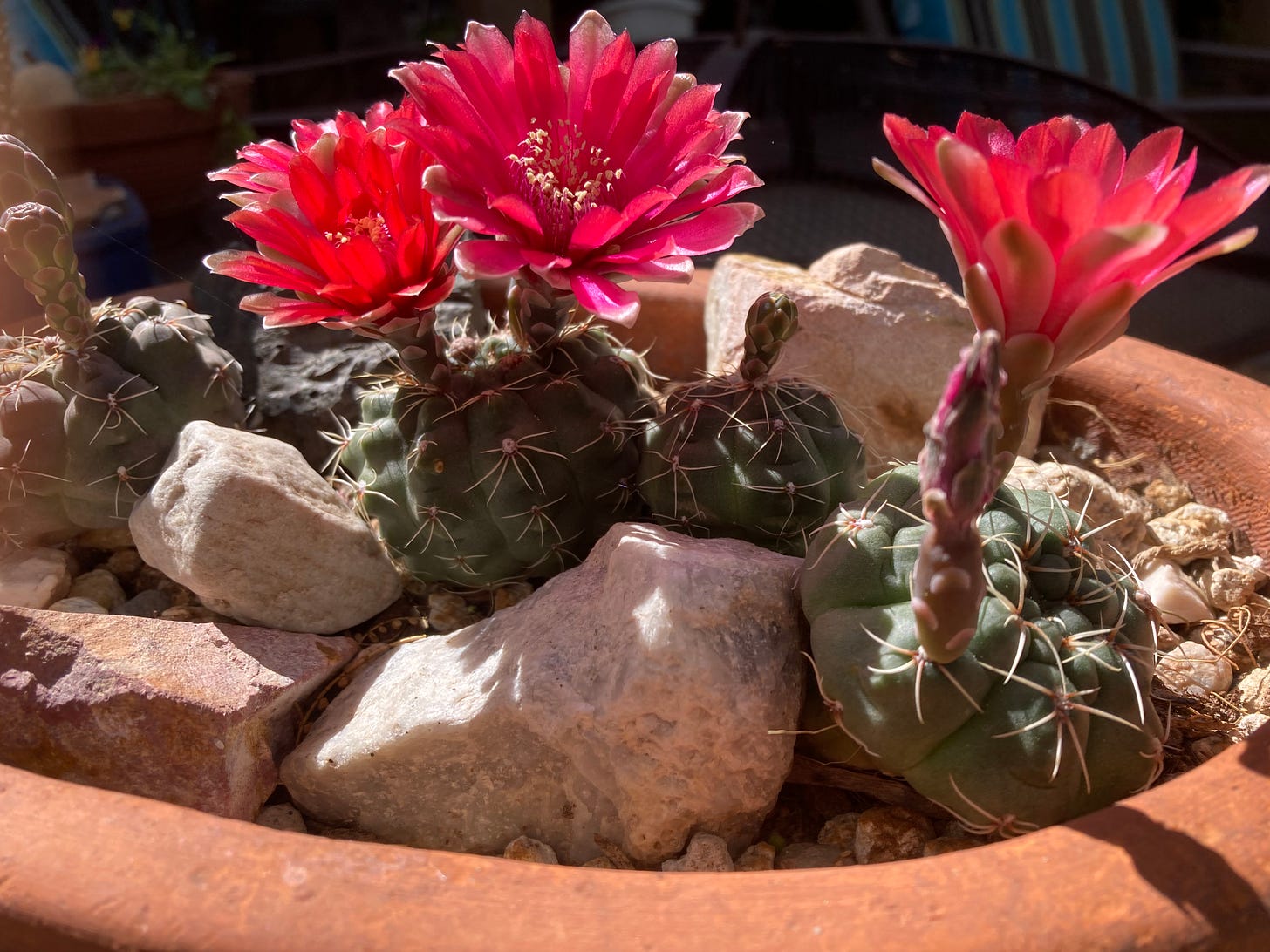
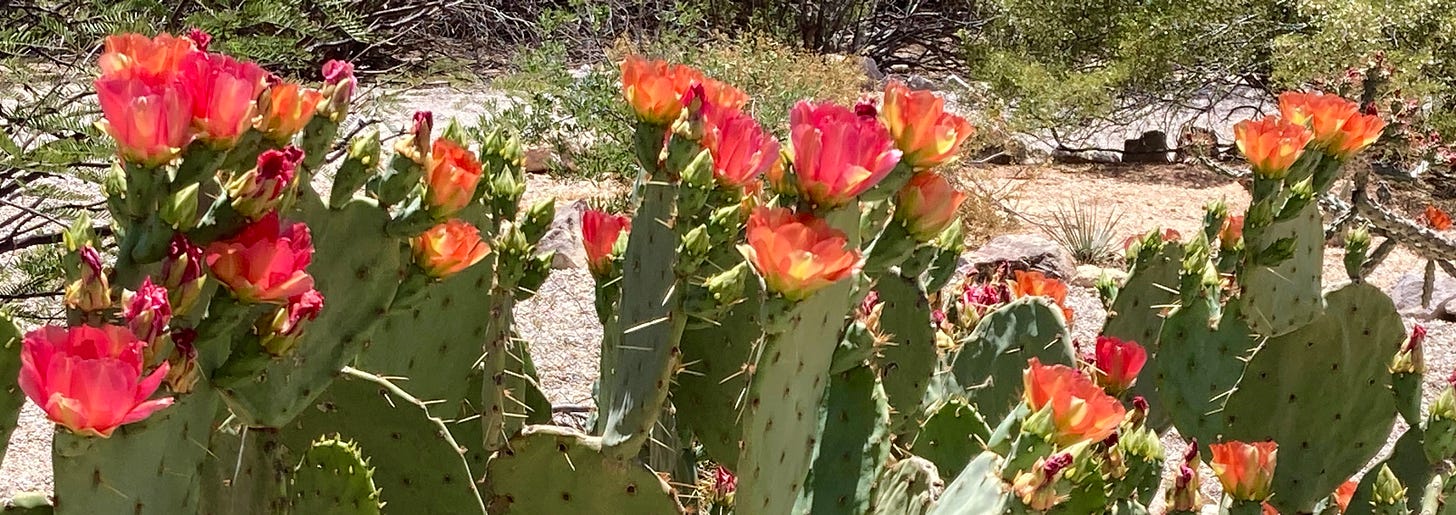

Thanks for the smiles, Mr. Fitz. You maybe forgot to mention the Mammillaria grahamii that thrive at the base of barrel cactuses and sport a beautiful pink crown of flowers after the summer chubascos. Some call them pincushion cactus; we call them Mammy Grahams. wink wink
Spadefoot Nursery is a very good source for desert plants. They are extremely knowledgeable and care alot about this blue ball we call home.